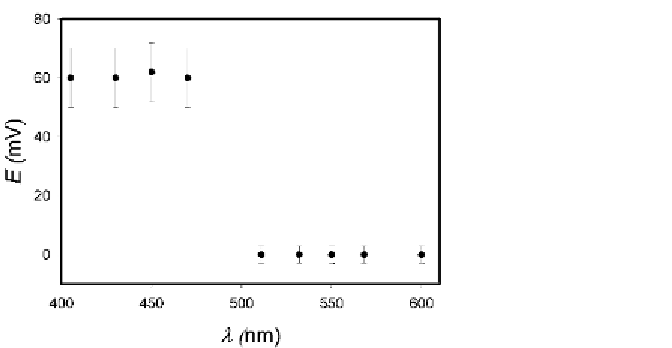Agriculture Reference
In-Depth Information
Fig. 24.6.
Action spectrum: dependence of action potential amplitude on wavelength of
irradiation
the phloem cells. The amount of cytoplasmic calcium increased slightly,
while the content of K
+
and Cl
−
was diminished after stimulation. Such
evidence leads to the conclusion that Ca
2+
influx as well as K
+
and Cl
−
efflux are involved in the propagation of action potentials. In an axon there
is K
+
and Na
+
transmembrane transport; conversely, in phloem cells the
K
+
,Ca
+
,andmorethanlikelyH
+
channels are involved in this process
(Fig. 24.8b).
Babourina et al. (2002) found that blue light induces significant changes
in activity of H
+
and Ca
2+
transporters within the first 10 min of exposure
to blue light, peaking between 3 and 5 min. Blue light induced the opening
of potassium and anion channels in plants and plant cells.
Some voltage-gated ion channels work as plasma membrane nanopoten-
tiostats. Blockers of ionic channels such as tetraethylammonium chloride
(TEACl) and ZnCl
2
stopped the propagation of action potentials in soy-
bean induced by blue light and inhibited phototropism in soybean plants.
Voltage-gated ionic channels control the plasma membrane potential and
the movement of ions across membranes; thereby, regulating various bi-
ological functions. These biological nanodevices play vital roles in signal
transduction in higher plants.
TEACl blocks voltage-gated potassium channels (Hille 2001). ZnCl
2
in-
hibits the function of calcium channels and possibly proton channels (Hille
2001). The propagation of action potentials with a constant amplitude and
speed depends on the work of the ion channels. These blockers inhibit the
propagation of action potentials induced by blue light (Volkov et al. 2005),
and inhibit phototropism in soybean plants (Fig. 24.9).

Search WWH ::

Custom Search